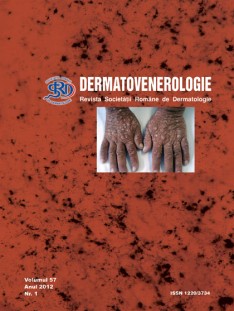Clinical trials and experimental
Dopamine expression in malignant melanoma
Introduction.
Recent reports explore the role of cathecolamines in malignant cells proliferations and the control of immune response in patients with neoplastic disease. Epinephrine and norepinefrine overregulates proangiogenic factors synthesis in malignant cells and induce angiogenesis in tumoral tissues. Dopamine inhibits angiogenesis by suppressing VEGF action in endothelial cells. There were detected enzymatic systems in the skin that assure the synthesis and degradation of cathecolmines and of its correspondent receptors. Taking into account these data, the aim of the study was to establish dopamine profile in melanoma patients.
Recent reports explore the role of cathecolamines in malignant cells proliferations and the control of immune response in patients with neoplastic disease. Epinephrine and norepinefrine overregulates proangiogenic factors synthesis in malignant cells and induce angiogenesis in tumoral tissues. Dopamine inhibits angiogenesis by suppressing VEGF action in endothelial cells. There were detected enzymatic systems in the skin that assure the synthesis and degradation of cathecolmines and of its correspondent receptors. Taking into account these data, the aim of the study was to establish dopamine profile in melanoma patients.
Material. Methods.
The study was made during two years based on the prospective analysis of 64 patients with melanoma in different stages of evolution, 5 patients with Dubreuihl melanosis, 40 individuals with nevi and 40 healthy subjects.
The biological samples (blood, urine collected in 24 hours) were taken before treatment. Dopamine determination was made by ELISA method.
Results.
Melanoma patients have a different model of dopamine expression compared with other studied clinical situations. In melanoma patients, dopamine has low plasmatic values (48,2 ± 16,1 pg/ml versus 58,5 ± 25,3 pg/ml in control, respectively 64,1 ± 39,7 pg/ml in nevi and 53,6 ± 21,8 pg/ml in circumscribed melanosis) and urinary values (148,5±91,6ug/24h versus 201,6 ± 160,7 ug/24 h in control, respectively 207,4 ± 147,8 ug/24 h in nevi and 210,1 ± 37,2 ug/24 h in circumscribed melanosis). In addition, tissue dopamine is higher in melanocytic benign proliferations versus malignant tissues (712,0±81,5pg/g protein in nevi, 501,7±171,4 pg/g protein in melanoma, respectively 602,7±106,1 pg/g protein in peritumoral healthy tissue) indicating dopamine involvement in cellular proliferation.
Conclusions.
The dopamine decrease tends to be associated with advanced stages of neoplasia. These results sustain the idea that cathecolamines are essential factors for tumoral development, especially for metastasis.


